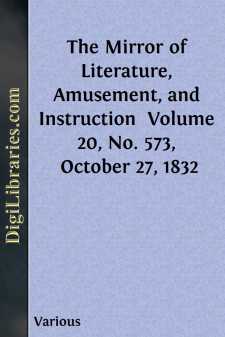Categories
- Antiques & Collectibles 13
- Architecture 36
- Art 48
- Bibles 22
- Biography & Autobiography 813
- Body, Mind & Spirit 142
- Business & Economics 28
- Children's Books 15
- Children's Fiction 12
- Computers 4
- Cooking 94
- Crafts & Hobbies 4
- Drama 346
- Education 46
- Family & Relationships 57
- Fiction 11829
- Games 19
- Gardening 17
- Health & Fitness 34
- History 1377
- House & Home 1
- Humor 147
- Juvenile Fiction 1873
- Juvenile Nonfiction 202
- Language Arts & Disciplines 88
- Law 16
- Literary Collections 686
- Literary Criticism 179
- Mathematics 13
- Medical 41
- Music 40
- Nature 179
- Non-Classifiable 1768
- Performing Arts 7
- Periodicals 1453
- Philosophy 64
- Photography 2
- Poetry 896
- Political Science 203
- Psychology 42
- Reference 154
- Religion 513
- Science 126
- Self-Help 84
- Social Science 81
- Sports & Recreation 34
- Study Aids 3
- Technology & Engineering 59
- Transportation 23
- Travel 463
- True Crime 29
The Mirror of Literature, Amusement, and Instruction Volume 20, No. 573, October 27, 1832
by: Various
Categories:
Description:
Excerpt
OLD HALL, IN DERBYSHIRE.
This picturesque specimen of olden architecture stands upon the Norton Lees estate, on the northern verge of Derbyshire upon the adjacent county of York; about a mile from Sheffield, and eight miles north of Chesterfield, and but a short distance from Bolsover Castle, pictured in No. 566 of The Mirror. "The estate, in the reign of Henry VII., was the property of the family of the Blythes of Norton, two of whom arrived at great honours in the church; one of them, John, being the Bishop of Salisbury, and the other, Geoffrey, Bishop of Lichfield and Coventry." The above was the mansion of the family: its picturesqueness is of pleasing character; and our inquiry into the probable age of the structure has naturally enough led us into a few observations upon the early domestic architecture of this country. The subject is, however, too rife with interesting details for the present occasion; so that all we now purpose is by way of reference to the specimen or illustration before us.
The house at Norton Lees has been supposed by some persons to be as old as the reign of Richard II.; but Mr. Rhodes observes, "that it was erected many years after this period can hardly be doubted." Certain features of resemblance assist its appearance of antiquity, as the wooden framework, which is observable in the oldest specimens of house-building in this country. According to Strutt, the Saxons usually built their houses of clay, kept together by wooden frames; shortly after the Norman Conquest plaster was intermixed with timber, and subsequently the basement story was made of stone. The upper apartments were so constructed as to project over the lower, and considerable ornament both in carved wood and plaster was introduced about the doors and windows and roof of the building. Nevertheless, timber, with lath and plaster, and thatch for the roofs, constituted the chief materials in the dwellings of the English from an early period till near the close of the fourteenth century and beginning of the fifteenth, when bricks began to be used in the better sort of houses. The mansion before us, as we have seen, is referred to the first-mentioned period. Mr. Rhodes, however, observes, "though composed of stone and wood, it is evident not one of the earliest structures of this description: it is indeed highly probable that it was built in the reign of the Seventh or Eighth Henry, but certainly not sooner. At this period the halls or family mansions of the yeomanry of the country had nearly all the same general character. Previously, but little stone was used in any of them."; It is true that stone houses are mentioned nearly three centuries and a half before the date of the hall at Norton Lees, as settled by Mr. Rhodes; as we find them belonging to citizens of London in the reign of Henry II.; "and," observes Mr. Hallam, "though not often perhaps regularly hewn stones, yet those scattered over the soil, or dug from flint quarries, bound together with a very strong and durable cement, were employed in the construction of manorial houses, especially in the western counties and other parts where that material is easily procured....












